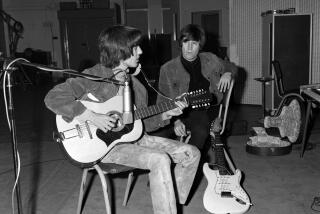The ‘Junkman’ Retireth : Watch Repairman Plans to Clock Out
R. T. Smith is finally winding down.
He’s scrawled the advertisement--”For Sale. This Place. Lock & Stock. $300,000”--on a small piece of faded paper and hung it near the counter of his cramped little shop inside the second floor of a Broadway office building downtown.
Businesswise, all this means is that somebody will eventually buy the intricate guts of hundreds of thousands of old or out-of-production watches--the springs and the crystals and the stems--that Smith has accumulated over the past 40 years as one of Los Angeles’ most senior watch repairmen.
But to scores of jewelers and watch collectors, Smith’s retirement has darker consequences.
In an age in which his craft is dying, Ray Smith has become one of the last guys who knows exactly where to find the right little piece for the right watch.
When your exasperated jeweler can’t find a balance wheel for that 60-year-old German model you wear, he may send you climbing into Smith’s cluttered realm.
“If Ray doesn’t have it, forget it. Nobody’s gonna do it,” said Tom Rush, manager of a Glendale jewelry equipment manufacturing company that has sought out Smith to fill difficult repair orders. “He’s sort of unique, because he’s been around so long that the parts nobody has catalogued, he knows ‘em by memory.”
It’s usually there, somewhere, in the rows of hundreds of old steel or wood cabinets, each bulging with thousands of different, delicate components of Hamiltons, Elgins and Omegas, to say nothing of Wittnauers, Agassizes and Tissots and Zodiacs.
The key word is somewhere.
Only the 67-year-old, white-haired Smith knows how to file through the maze. He’s never compiled an inventory.
“Keep it in my head,” he says pleasantly. “If you wrote it down, it’d take you 364 days a year.”
“He’s the junkman of the horological industry,” said Jay Foreman, a veteran downtown watch and clock repair shop owner who once served on the board of directors of the 7,500-member American Watchmakers Institute.
Smith has been buying, repairing and selling from Broadway since 1946, when he bought the stock and office of an elderly jeweler named E. L. Deacon, who had been doing business in Los Angeles since before the turn of the century. In respect, the largest business sign inside Smith’s shop contains an acknowledgment of Deacon.
Smith said he heard his calling early in the farming town of Deckerville, Mich.
“Been watchmaking since I was 9,” he said. “Everything mechanical came natural--watches, auto repair, everything. I made my own tools, started with dollar pocket watches, buying and re-selling them. Had a regular route for that.
“I finished the eighth grade, but I’d already had four brothers and sisters go to high school, so I couldn’t go, not with 11 kids in the family. I got an apprenticeship at 13.”
He wound up in Los Angeles after serving in the Army during World War II and began building up his huge inventory with the lust of an inveterate collector, steadily buying supplies from watch companies that folded or of other watch repairmen who retired or went out of business.
Smith said he bought with no particular strategy. He just grabbed watch parts wherever he found them.
Balance Wheels
“I knew this time was going to come, so I saved this stuff for 40 years,” he said, opening a tray of balance wheels. “Now look at these. Company closed down 10, 15 years ago. Nobody else has ‘em. I just hang onto em. Anytime a plant closes up, they call me. Nobody in the United States has half what I have.”
“The guy’s got parts coming out of his ears,” said Harry Nathan, a part-time manager of a Sherman Oaks jewelry store who stopped by one day last week in search of a hard-to-find used watch movement to replace a rusted one. “I still don’t know how the hell he knows where everything is.”
The answer is patience. Like a doctor rummaging through the world’s biggest pharmacy, Smith will wander from dusty cabinet to cabinet, searching, discounting, narrowing, remembering.
“I’ll tell you something else,” said Nathan, growing a bit impatient as Smith interrupted his search for Nathan’s piece to help another customer, “this is the only guy I’ve met who has taken the time or effort for a lousy little $2 or $3 item that the average jeweler wouldn’t take the time for. I’ve seen him spend 20 minutes for that.”
Number Fading
Because of the dominance of the computer chip-operated quartz watch and the relative simplicity of repairing it, the number of experienced watch repairmen is fading. A recent survey by the Denver-based Watch and Clock Review magazine found the average repairman is 63 years old.
“You can be taught to repair a quartz watch in a two-week course,” said Jane Barrick, the magazine’s managing editor. “It’s not the craft it used to be.”
“The young fellows don’t wanna put in the time to learn,” Smith said. “They think it’s a dead issue, but it’s not.”
More to Read
Inside the business of entertainment
The Wide Shot brings you news, analysis and insights on everything from streaming wars to production — and what it all means for the future.
You may occasionally receive promotional content from the Los Angeles Times.










